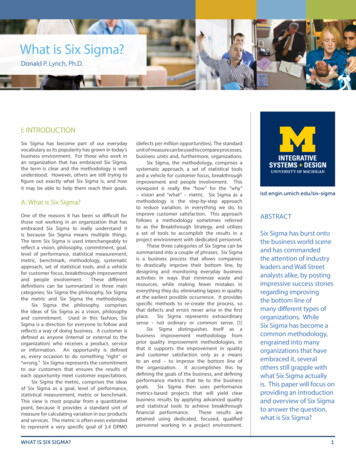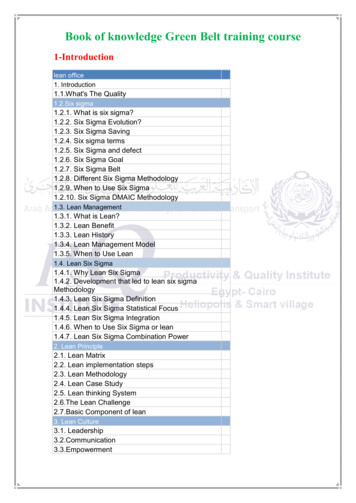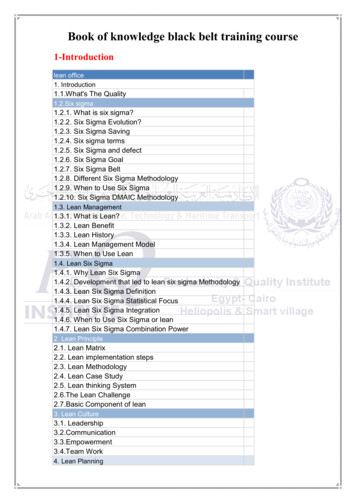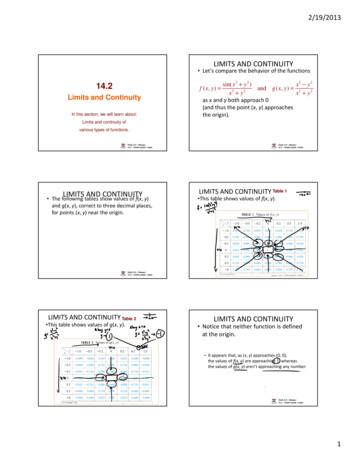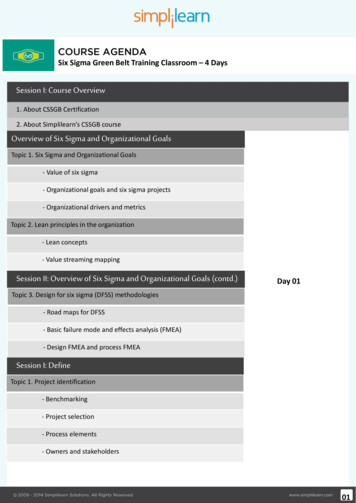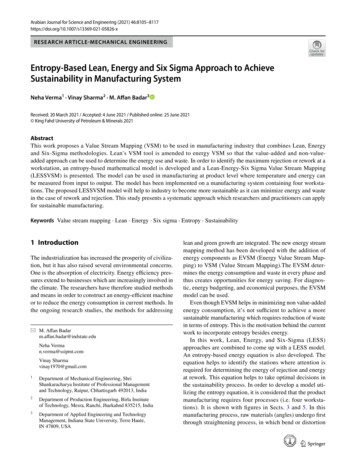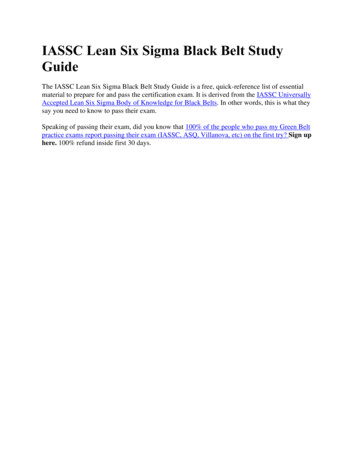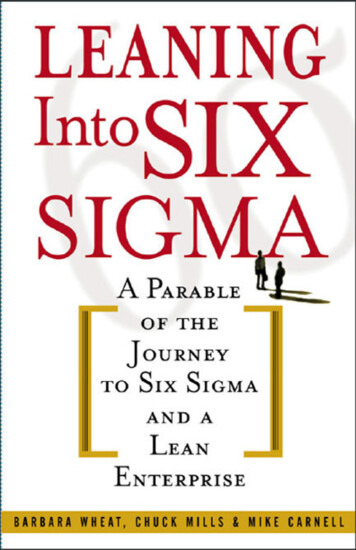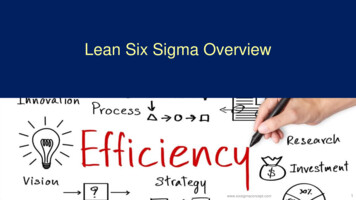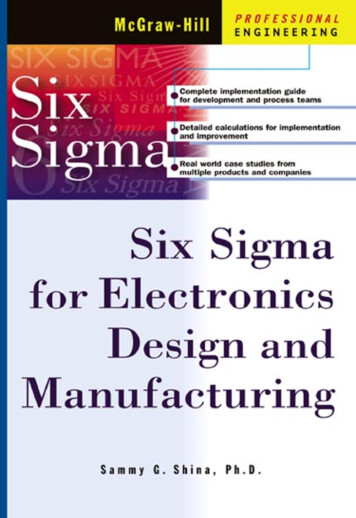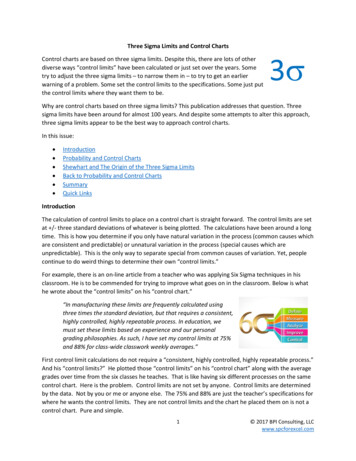
Transcription
Three Sigma Limits and Control ChartsControl charts are based on three sigma limits. Despite this, there are lots of otherdiverse ways “control limits” have been calculated or just set over the years. Sometry to adjust the three sigma limits – to narrow them in – to try to get an earlierwarning of a problem. Some set the control limits to the specifications. Some just putthe control limits where they want them to be.Why are control charts based on three sigma limits? This publication addresses that question. Threesigma limits have been around for almost 100 years. And despite some attempts to alter this approach,three sigma limits appear to be the best way to approach control charts.In this issue: IntroductionProbability and Control ChartsShewhart and The Origin of the Three Sigma LimitsBack to Probability and Control ChartsSummaryQuick LinksIntroductionThe calculation of control limits to place on a control chart is straight forward. The control limits are setat /- three standard deviations of whatever is being plotted. The calculations have been around a longtime. This is how you determine if you only have natural variation in the process (common causes whichare consistent and predictable) or unnatural variation in the process (special causes which areunpredictable). This is the only way to separate special from common causes of variation. Yet, peoplecontinue to do weird things to determine their own “control limits.”For example, there is an on-line article from a teacher who was applying Six Sigma techniques in hisclassroom. He is to be commended for trying to improve what goes on in the classroom. Below is whathe wrote about the “control limits” on his “control chart.”“In manufacturing these limits are frequently calculated usingthree times the standard deviation, but that requires a consistent,highly controlled, highly repeatable process. In education, wemust set these limits based on experience and our personalgrading philosophies. As such, I have set my control limits at 75%and 88% for class-wide classwork weekly averages.”First control limit calculations do not require a “consistent, highly controlled, highly repeatable process.”And his “control limits?” He plotted those “control limits” on his “control chart” along with the averagegrades over time from the six classes he teaches. That is like having six different processes on the samecontrol chart. Here is the problem. Control limits are not set by anyone. Control limits are determinedby the data. Not by you or me or anyone else. The 75% and 88% are just the teacher’s specifications forwhere he wants the control limits. They are not control limits and the chart he placed them on is not acontrol chart. Pure and simple.1 2017 BPI Consulting, LLCwww.spcforexcel.com
The teacher did see some things to improve. But this will often happen if you just plot the data overtime. But that doesn’t make it a control chart to allow you to separate special causes from commoncauses.Sometimes people just use the specification limits as the control limits. Some use “two-sigma” limits.Others just change the control limits to what their manager wants them to be. Still others treat acontrol chart as a sequential test of a hypothesis and associate an error rate with the control chart –which essentially treats the control limits as “probability” limits.Does it really matter how the control limits are set? After all, there is some gain simply from plotting thedata over time. Yes, it does matter how control limits are set. The problem is that we seem to havemade the control chart a more complex tool than it needs to be in recent years. One reason this hashappened is we began to worry about probabilities instead of letting our knowledge of the process helpus.Probability and Control ChartsSome of us appear to have lost sight of what a control chart is supposed to do. We seem to focus moreand more on probabilities. You have heard this no doubt: the probability of getting a point beyond thecontrol limits is 0.27% (assuming your data are normally distributed) even when your process is instatistical control (just common causes present). Or conversely, the probability of getting a point withinthe control limits is 99.73% when your process is in statistical control. I am guilty of doing this in somemy writings over the years. We worry about increasing those false signals – assuming something is aspecial cause when it is due to common cause.Some people look at a control chart as a series of sequential hypothesis testsand assign an error rate to the entire control chart based on the number ofpoints. This on-line article does that and recommends increasing the threesigma limits to larger values as the number of points on the chart increases. Infact, they appear to scoff at the reason the three sigma limits were originallyset:“Well, Shewhart and Deming would tell you that they have been shown to work well in practice,that they minimize the total cost from both overcorrecting and under-correcting.”And then they say that the reason the three sigma limits worked was because everything was based on25 subgroups. They then talk about the Type 1 error. The probability of getting a point beyond thecontrol limits is 0.27% even when the process is in statistical control. So, using the sequential hypothesistest approach, the probability of getting a point beyond the control limits for 25 points on a controlchart is:1 - 0.997325 0.065This means that there is 6.5% chance of a point being out of control whenever you have a control chartwith 25 subgroups. And as you add more points, that probability increases. For 100 points, theprobability is given by:1 - 0.9973100 0.2372 2017 BPI Consulting, LLCwww.spcforexcel.com
So, there is a 23.7% chance of one point being beyond the control limits with a control chart that has100 points. They recommend you increase the number of sigma limits to get the error rate close to 0.05.For 100 points, they recommend you use 3.5 sigma limits. This drop the error rate to less than 0.05.If you view control charts from the probability approach, what this articlestates is true. I did a small experiment to confirm this. I wrote a little VBA codeto generate random numbers from a normal distribution with a mean of 100and standard deviation of 10. I then generated 100 control charts containing 25subgroups and determined the number of out of control points when usingthree sigma limits. I repeated the process for 100 control charts containing 100subgroups and, again, determined the number of out of control points whenusing three sigma limits.For the 100 charts containing 25 subgroups, there were 6 control charts with at least one point beyondone of the control limits. So very close to the 6.5% mentioned above.For the 100 control charts containing 100 subgroups, there were 30 control charts with at least onepoint beyond one of the control limits. So, 30% had “false signals.” A little higher than the 23.7% shownabove.I then changed the control limits to be 3.5 sigma limits and generated 100 control charts with 100subgroups. For those 100 control charts, there were 6 control charts with at least one point beyond oneof the control limits. Expanding the limits from 3 to 3. 5 for a control chart with 100 subgroups droppedthe % of control charts with false signals from 30% to 6%. Not surprising since the control limits arewider at 3.5 sigma. The table below summarizes the results of the simulation.Table 1: Summary of Sigma Limit Simulation for 100 Control ChartsSigmaLimits333.5Number ofSubgroups25100100Number of Control Chartswith Out of Control Points6306But is this something you should do? Change the number of sigma limits based on the number of points?We seemed to have lost our focus on what control charts are used for. Let’s go back to the start ofcontrol charts with Dr. Walter Shewhart.Shewhart and The Origin of the Three Sigma LimitsDr. Walter Shewhart is regarded as the “father of statistical quality control.” He developed the controlchart almost 100 years ago. Control charts were described in 1931 in his book Economic Control ofQuality of Manufactured Product. He is the one who set the control limits at three sigma. How did hearrive at this?Dr. Shewhart divided variation in a process into two categories: controlled variation and uncontrolledvariation. Controlled variation is the process variation that is described by a consistent and predictablepattern of variation. He said this type of variation was due to “chance” causes. It is what we call3 2017 BPI Consulting, LLCwww.spcforexcel.com
common causes of variation. Uncontrolled variation is described as patterns of variation that changeover time unpredictably. He said these unpredictable changes were due to assignable causes, what wecall special causes more often today.The control chart he developed allows us to determine what type of variation we are dealing with. Doesthe process show unpredictable variation? Or does the process show predictablevariation?Why should you care what type of variation you have present? The answer is thatthe type of action you take to improve a process depends on the type of variationpresent. If your process has variation that is consistent and predictable(controlled), the only way to improve this process is to fundamentally change theprocess. The key word is fundamental. But, if the process has unpredictablevariation, the special cause responsible for the unpredictability should be identified. If the special causehurts the process, the reason for the special cause needs to be found and eliminated. If a special causehelps the process, the reason for the special cause should be found and incorporated into the process.This concept of common and special causes is the foundation of the control charts Shewhart developed.A process that has consistent and predictable variation is said to be in statistical control. A process thathas unpredictable variation is said to be out of statistical control.So, how did Shewhart determine that three sigma limits were the correct ones to use? Here is a quotefrom his book mentioned above:“For our present purpose, a phenomenon will be said to be controlled when, through the use ofpast experience, we can predict within limits, how the phenomenon may be expected to behavein the future. Here it is understood that prediction within limits means that we can state, at leastapproximately, the probability that the observed phenomenon will fall within the given limits.”And more from his book:“We must use limits such that through their use we will not waste too much time lookingunnecessarily for trouble.”“The method of attack is to establish limits of variability . . . such that, when an observation isfound outside these limits, looking for an assignable cause is worthwhile.”” We usually choose a symmetrical range characterized by limits µ t .”“Experience indicates t 3 seems to be an acceptable economic value”“Construct control charts with limits µ t for each statistic. If an observed point falls outsidethese limits, take this fact as an indication of trouble or lack of control.”Shewhart’s choice of three sigma limits considered more than just probability. The second part of thefirst quote above talks about probability but there was much more to his decision. The strongestjustification appears to be the simple fact that they work. It is trade-off between making one of twomistakes – assuming that a result is due to a special cause of variation when in fact it is due to commoncauses or assuming that a result is due to common causes when in fact it is due to a special cause. You4 2017 BPI Consulting, LLCwww.spcforexcel.com
will make one of these two mistakes sometimes. The three sigma limits represent a method ofminimizing the cost associated with making these mistakes.Here is one more quote:“Hence the method for establishing allowable limits of variation in a statistic depends upon thetheory to furnish the expected value and the standard deviation of the statistics and uponempirical evidence to justify the choice of limits.”So, you need a method of calculating an average and a standarddeviation of what you are plotting. That is the statistical part.But, the empirical evidence appears to have been the key. Andfrom Dr. Donald Wheeler in his book Advanced Topics inStatistical Process Control:“Three sigma limits are not probability limits. .it is important to remember that there otherconsiderations which were used by Shewhart in selecting this criterion .the strongestjustification of three-sigma limits is the empirical evidence that the three sigma limits work wellin practice – that they provide effective action limits when applied to real world data.”In Dr. Wheeler’s book, he does use some statistics to explain why the control limits work so well, butclearly states that these statistics “cannot further justify the use of three sigma limits, but reveal one ofthe reasons they work so well.”Back to Probability and Control ChartsDr. Wheeler wrote explicitly about control charts and the probability approach in his book referencedabove. This section summarizes some of his points. First, remember what control charts do. Theydetermine if there is controlled or uncontrolled variation in a process. This is what a control chart does.What is the probability approach to control charts? You have seen it above – that control limits arecalculated so that 99.73% of the time a point will be within the control limits and 0.27% of the time outof the control limits. Dr. Wheeler points out that Shewhart addressed this in his book. EssentiallyShewhart wrote that if a process was perfectly stable and if we knew the details of the underlyingstatistical distribution, then we could work in terms of probability limits.But that is not the real world. In reality, we never know those two things for sure. Nor do we ever knowfor sure the average and the measure of dispersion (e.g., standard deviation) of whatever underlyingdistribution there may be. So, the probability approach does not apply. The assumptions needed toapply this approach are not met – knowing the process is stable, knowing the exact underlyingdistribution, knowing the exact average and knowing the exact measure of dispersion. “Thus a majorproblem with the probability approach to control charts is that it is totally out of contact with the realworld.”Dr. W. Edwards Deming also spoke about this in his book Out of the Crisis. Dr. Deming said:“The calculations that show where to place control limits on a chart have their basis in the theoryof probability. It would nevertheless be wrong to attach any particular figure to the probabilitythat a statistical signal for detection of a special cause could be wrong, or that the chart could5 2017 BPI Consulting, LLCwww.spcforexcel.com
fail to send a signal when a special cause exists. The reason is that no process, except in artificialdemonstrations by use of random numbers, is steady, unwavering.”Dr. Deming goes on to say:“Rules of detections of special causes and for action on them are not tests of hypothesis that thesystem is a stable process.”The probability approach has led to people putting restrictions on control charts. The data must benormally distributed. Control charts work because of the central limit theorem (our May 2017publication addresses this fallacy). This has hurt the use of control charts over time.Control charts are consistent with theory but it is the empirical evidence that theywork that takes them outside the restrictions of the probability approach. Controlcharts work in the real world – unlike the assumptions needed to use the probabilityapproach. It is hard for some of us to accept that control limits work because of allthe empirical results.SummaryThis publication looked at three sigma limits and the justification behind them. Some approach controlcharts with probabilities. While Shewhart considered probabilities in his three sigma approach, therewere other more important considerations. The major one was that the three sigma limit work in thereal world. They give a good balance between looking for special causes and not looking for specialcauses. The concept of three sigma limits has been around for almost 100 years. Despite attempts tochange the approach, the three sigma limits continue to be effective. There is no reason to use anythingelse on a control chart. Dr. Shewhart, Dr. Deming and Dr. Wheeler make pretty convincing argumentswhy that is so.Quick LinksVisit our home pageSPC for Excel SoftwareSPC TrainingSPC ConsultingSPC Knowledge BaseOrdering InformationThanks so much for reading our publication. We hope you find it informative and useful. Happy chartingand may the data always support your position.Sincerely,Dr. Bill McNeeseBPI Consulting, LLC6 2017 BPI Consulting, LLCwww.spcforexcel.com
control limits is 0.27% even when the process is in statistical control. So, using the sequential hypothesis test approach, the probability of getting a point beyond the control limits for 25 points on a control chart is: 1 - 0.997325 0.065 This means that there is 6.5% chance of a point being out of control

